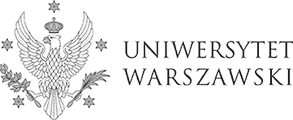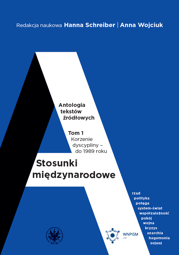Informacje o publikacji
| Wydanie: | 1 |
| Miejsce i rok wydania: | Warszawa 2025 |
| Język publikacji: | angielski |
| ISBN/ISSN: | 978-83-235-6483-6 |
| EAN: | 9788323564836 |
| Liczba stron: | 482 |
| Oprawa: | Twarda |
| Format: | 17x24 cm |
| Sposób publikacji: | Druk |
| Waga: | 1015 g |
| Typ publikacji: | Praca naukowa |
| DOI: | https://doi.org/10.31338/uw.9788323564836 |
The appearance of the audiovisual series as a dominant genre on the broadcast entertainment scene was preceded by the millennia-long evolution of episodic narration. The book begins with an inquiry into the history and development of episodic narration to later provide a chronological survey of almost five hundred 21st-century audiovisual series (films are included for context) inspired by classical Antiquity. The data gathered in the survey are then analyzed from the point of view of the variety and frequency of the used myths and classical references, as well as compared with the significant scholarship on the reception of Antiquity (until recently, traditionally focused on cinema). The last chapters pull together a coherent image of the main themes and trends in the 21st-century audiovisual serial narratives inspired by Graeco-Roman mythology.
Keywords: Graeco-Roman mythology, serial episodic narrative, classical reception, 21st century audiovisual productions, Antiquity-inspired audiovisual series.
******
Ta pieśń nie kończy nigdy się. Mitologia klasyczna w XXI-wiecznych serialach telewizyjnych dla młodzieży
Zanim seriale zdominowały telewizję rozrywkową, poprzedziła je dobrze ponad tysiącletnia ewolucja narracji w odcinkach. Książka nakreśla najpierw historię i rozwój epizodycznej narracji, a potem przechodzi do chronologicznego przeglądu prawie pięciuset nakręconych w XXI wieku seriali telewizyjnych dla młodzieży zainspirowanych mitologią starożytną (z dodanymi dla kontekstu filmami). Tak zgromadzone dane zostały następnie zbadane pod względem różnorodności i częstotliwości użytych w serialach mitów i odniesień do starożytności, jak również porównane z literaturą naukową na temat recepcji antyku (do niedawna zajmującej się raczej kinem). Dalsze rozdziały książki przedstawiają spójny obraz głównych tematów i tendencji w serialach telewizyjnych XXI wieku powstałych pod wpływem mitologii grecko-rzymskiej.
Keywords: Graeco-Roman mythology, serial episodic narrative, classical reception, 21st century audiovisual productions, Antiquity-inspired audiovisual series.
******
Ta pieśń nie kończy nigdy się. Mitologia klasyczna w XXI-wiecznych serialach telewizyjnych dla młodzieży
Zanim seriale zdominowały telewizję rozrywkową, poprzedziła je dobrze ponad tysiącletnia ewolucja narracji w odcinkach. Książka nakreśla najpierw historię i rozwój epizodycznej narracji, a potem przechodzi do chronologicznego przeglądu prawie pięciuset nakręconych w XXI wieku seriali telewizyjnych dla młodzieży zainspirowanych mitologią starożytną (z dodanymi dla kontekstu filmami). Tak zgromadzone dane zostały następnie zbadane pod względem różnorodności i częstotliwości użytych w serialach mitów i odniesień do starożytności, jak również porównane z literaturą naukową na temat recepcji antyku (do niedawna zajmującej się raczej kinem). Dalsze rozdziały książki przedstawiają spójny obraz głównych tematów i tendencji w serialach telewizyjnych XXI wieku powstałych pod wpływem mitologii grecko-rzymskiej.
In this book, the reader feels “well looked after” and at all times aware of what the author is up to. The prequel is a fabulous resource, delivered with style. I also especially appreciate the declaration of the book being written from an “outsider’s” point of view, drawing attention to the cultural and scholarly consequences of the Cold War. This observation will help readers reflect on this important dimension […]. It provides the opportunity for reflection on “Western” predilections, research interests, perceived/received wisdoms, etc. […] Given the data set feeding the volume, it is likely that the book will (in practice) act as a reference and starting place for students embarking on their own reception case studies. It will be very useful for this. […] That said, it will also be a key resource for postgraduate students and reception scholars.
Henry Stead, University of St Andrews
From the editorial review
Each chapter is thoughtfully organized, and the author provides detailed explanations and interpretations that allow readers to grasp the intricacies of classical reception in a quintessentially modern medium. […] The publication will be useful not only for academics, but for students and PhD students at universities in the fields of classical studies, mythology, and media studies. Furthermore, its academic thoroughness combined with erudite and lively style will likely be of interest to educators and teachers of classical mythology or related subjects, offering them new perspectives and ideas for incorporating audiovisual series into their teaching methods. Further audiences might include fans of audiovisual series with mythological themes, as the book provides a scholarly examination of how these series engage with classical mythology. Last but not least, libraries and academic institutions focusing on humanities, media studies, or related subjects may consider adding this book to their collections to provide a resource for students, researchers, and faculty members interested in the intersection of classical mythology and contemporary audiovisual media. […] Even more, with its interdisciplinary approach, engaging writing style, and thorough research, the book successfully bridges the gap between academia and popular culture. […] this book’s insightful analysis and thought-provoking discussions make it a recommended read for those seeking a deeper understanding of the enduring appeal of classical mythology in contemporary media.
Brane Senegačnik, University of Ljubljana
From the editorial review
Recenzja autorstwa Edyty Gryksa-Pająk opublikowana w dwutygodniku "artPAPIER" » ANTYK - CZAS, KTÓRY NIGDY SIĘ NIE KOŃCZY
Henry Stead, University of St Andrews
From the editorial review
Each chapter is thoughtfully organized, and the author provides detailed explanations and interpretations that allow readers to grasp the intricacies of classical reception in a quintessentially modern medium. […] The publication will be useful not only for academics, but for students and PhD students at universities in the fields of classical studies, mythology, and media studies. Furthermore, its academic thoroughness combined with erudite and lively style will likely be of interest to educators and teachers of classical mythology or related subjects, offering them new perspectives and ideas for incorporating audiovisual series into their teaching methods. Further audiences might include fans of audiovisual series with mythological themes, as the book provides a scholarly examination of how these series engage with classical mythology. Last but not least, libraries and academic institutions focusing on humanities, media studies, or related subjects may consider adding this book to their collections to provide a resource for students, researchers, and faculty members interested in the intersection of classical mythology and contemporary audiovisual media. […] Even more, with its interdisciplinary approach, engaging writing style, and thorough research, the book successfully bridges the gap between academia and popular culture. […] this book’s insightful analysis and thought-provoking discussions make it a recommended read for those seeking a deeper understanding of the enduring appeal of classical mythology in contemporary media.
Brane Senegačnik, University of Ljubljana
From the editorial review
Recenzja autorstwa Edyty Gryksa-Pająk opublikowana w dwutygodniku "artPAPIER" » ANTYK - CZAS, KTÓRY NIGDY SIĘ NIE KOŃCZY
Zobacz również
Inni klienci kupili również



W cierpieniu nie ma nic pozytywnego49,00 zł
44,10 zł
Szczegóły
- Wywiad rzeka zajmuje szczególne miejsce w życiu polskiej inteligencji. Wywiad z Pawłem Śpiewakiem dotyka głównych tematów jego twórczości i zainteresowań: polskich podziałów, związków pamięci i historii, splątanych tożsamości – polskiej i żydowskiej

La Unión Europea ante inteligencia artificial: aspectos legales, éticos y sociales en Polonia y España y nuevas perspectivas legislativas41,00 zł
36,90 zł
Szczegóły
- La publicación presenta los retos normativos de la inteligencia artificial desde la perspectiva de diversos ámbitos jurídicos. La aplicación de la inteligencia artificial conlleva a la vez muchos beneficios y numerosos riesgos y dilemas que el Derecho

5 prac, które zmieniły oblicze fizyki29,00 zł
26,10 zł
Szczegóły
- Niniejszy tom zawiera 5 artykułów, które Albert Einstein opublikował w pamiętnym 1905 roku. Prace te raz na zawsze zmieniły nasze poglądy na naturę czasu, przestrzeni i światła, autorowi zaś przyniosły sławę. Rozprawa o nowej metodzie określania rozmiarów

Update Required
To play the media you will need to either update your browser to a recent version or update your Flash plugin.




















